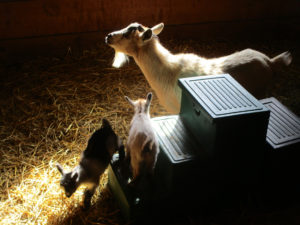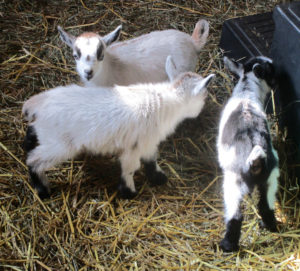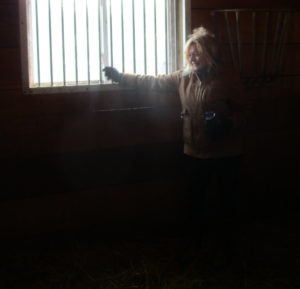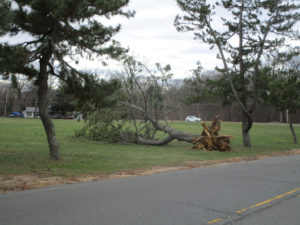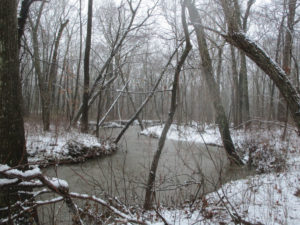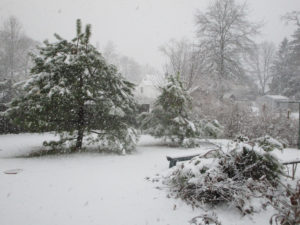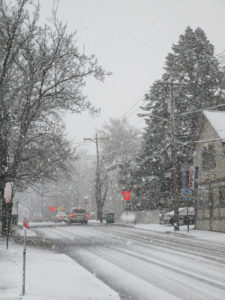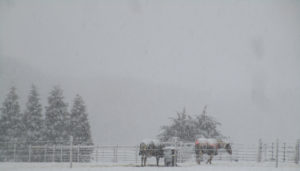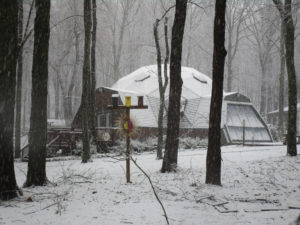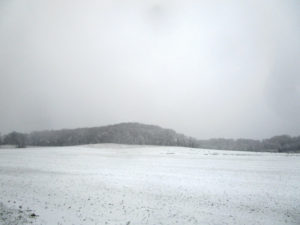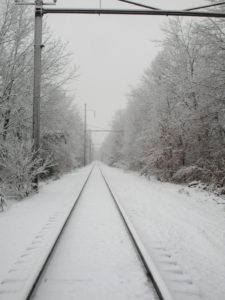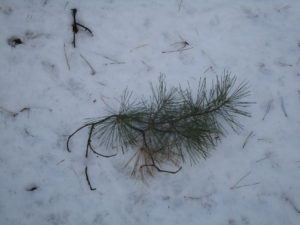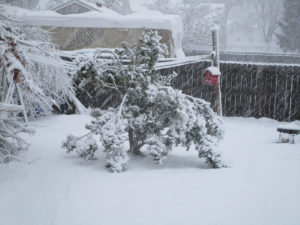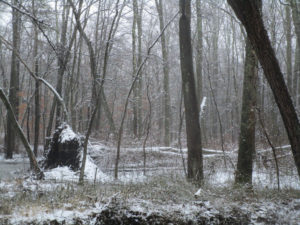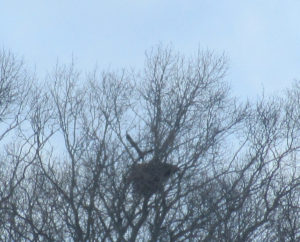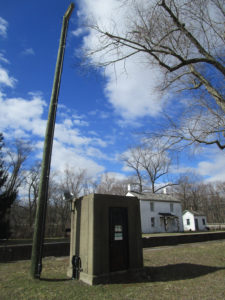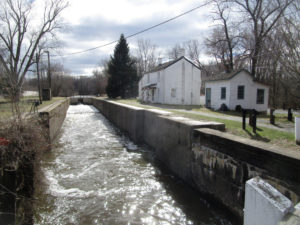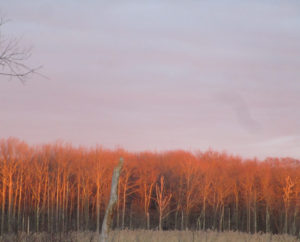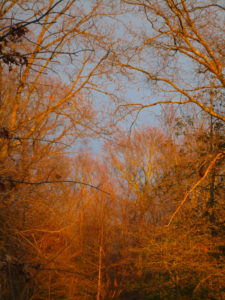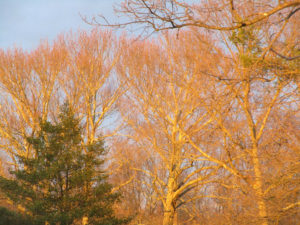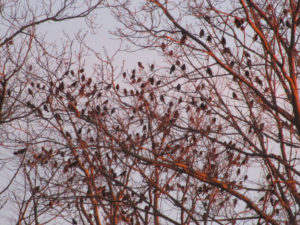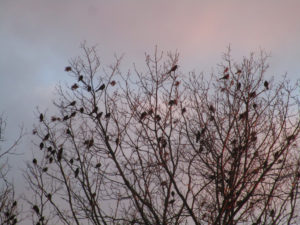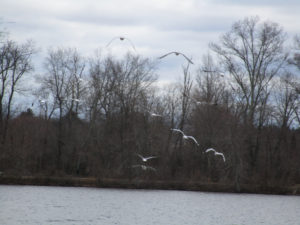Notes from Garden and Afield in the Jersey Midlands — Week of 2018, March 4
Article and photos by Joe Sapia
A nanny with two of her three new kids at Cranbury Brook Farm in Monroe, Middlesex County.
NEW KIDS IN TOWN: A few days ago, Laurie Ann Kozinsky Winter welcomed three “kids” to her Cranbury Brook Farm in Monroe — that is, three baby goats. On Sunday, March 4, Laurie Ann opened up her farm for a few hours so the community could visit the kids (all females) and their mom, the nanny.
The three young ladies at Cranbury Brook Farm.
As a lifelong Monroe resident of 61 years, I have watched the township of a little more than 43 square miles grow from an estimated 5,000 people to today’s estimated 50,000. So, today’s visit to the farm, which sits on Cranbury Brook, was a visit back in time — when the part of Monroe south of Jamesburg was simply “The Farms.”
A mother’s care at Cranbury Brook Farm.
My maternal Onda-Poznanski family and Laurie Ann’s maternal side have know each other for a hundred or so years. Laurie Ann’s maternal grandmother, Anna Kozinsky, and I lived in the same Helmetta Road area of Monroe. Laurie Ann and I are four days apart in age — Grrrrrr, I am the older one — and attended Holy Trinity Church in Helmetta and St. Mary School in South River — both Polish-Catholic institutions for us good Polski-Catholic children. At the farm, I got to talk to some of Laurie Ann’s children and caught up with her parents, Anna and Danny Kozinsky. So, it was a reunion of families, too.
What was supposed to be a short stay turned into about three hours — and about 120 photographs.
1967, January — Little Laurie Ann and little Joey, both 10-years-old, in the 5th grade at St. Mary School, South River, Middlesex County, where good Polish-Catholic kids went to school.
SHOUT OUT TO FARMER LAURIE ANN KOZINSKY WINTER: The GOAT (Greatest of All Time) — farm owner Laurie Ann Kozinsky Winter. Or as I call her, Princess Winter Spring Summer Fall. (Baby-boomers would understand the Princess moniker — and notice the mix-up of words.) A shout-out to Laurie Ann — A loving wife who lost her husband, Greg, over the summer after a long battle with cancer; she is very dedicated to her elderly parents; and she is a mother and grandmother. A Jersey Girl!
Laurie Ann Kozinsky Winter, owner of Cranbury Brook Farm in Monroe, Middlesex County.
MARCH 1 to 3 NOR’EASTER: We were still cleaning up from the March 1 to 3 nor’easter…
Here in Thompson Park in Monroe, Middlesex County, this fallen tree was a victim of the March 1 to 3 nor’easter. Then, on Wednesday, March 7, we got hit with another nor’easter…
MARCH 7 NOR’EASTER: Meteorologists were having trouble forecasting snow totals for the Wednesday, March 7, nor’easter. Where would the rain/snow line be? A difference of only a few miles could mean a drastic difference in snowfall — Look at the following figures from Somerset County, a 15-inch difference! The National Weather Service reported the following snowfall totals by county. I am listing the reported highs and lows. Keep in mind this may be an incomplete report:
Burlington County: 3.3 inches at Pemberton to 9.5 inches at Moorestown and Cinnaminson.
Hunterdon County: 6.0 in East Amwell to 15.5 in the Stockton area.
Mercer County: 6.1 in the Trenton-Ewing area to 11.5 at Hamilton.
Middlesex County: 2.0 in the Old Bridge area to 9.4 at Cranbury. (I recorded an estimated 6.0 at the part of Monroe between Helmetta and Jamesburg.)
Monmouth County: 1.3 at Keyport to 7.6 in the Upper Freehold area.
Ocean County: 0.4 at Lacey to 3.2 in the Jackson area.
Somerset County: 7.1 at Somerville to 22.0 at Green Brook.
Bucks County, Pennsylvania: 6.5 in the Oakford area to 11.1 in Langhorne.
The S-curve of Manalapan Brook in Monroe, Middlesex County, known as the “Old Swimming Hole.”
SNOWFALL: With the Wednesday, March 7, nor’easter, where I live — in the Helmetta-Monroe-Jamesburg area of Middlesex county — has surpassed the seasonal snowfall average. The nor’reaster dropped 6 inches, bringing the seasonal total to 28 inches. Normal would be about 26 inches, based in New Brunswick about 7.5 miles away. And we still have about 4 weeks left in the snowfall season.
A March 7 nor’easter scene in my backyard in Monroe, Middlesex County.
OTHER SCENES FROM THE MARCH 7 NOR’EASTER:
The snow begins in Hightstown, Mercer County.
A Monmouth County Department of Public Works And Engineering plow on Route 571 in the part of Millstone, Monmouth County, between Roosevelt and ETRA.
Horses in Roosevelt, Monmouth County.
One of the famed geodisic dome houses in Roosevelt, Monmouth County.
Disbrow Hill, or “Crematory Hill,” in Millstone, Monmouth County.
ConRail freight railroad tracks in the part of Monroe, Middlesex County, between Jamesburg and Helmetta.
HOW THESE NOR’EASTERS LIVE ON: We may not realize it, but we will see remnants of Wednesday’s nor’easter for years to come in fallen or bent trees, because of the high wind and the heavy, wet spring snow.
A branch of a pitch pine, “Pinus rigida,” that fell because of the March 7 nor’easter in an East Brunswick section of the Middlesex County Department of Parks and Recreation-operated Jamesburg Park Conservation Area. This is part of my beloved Pine Barrens around Helmetta.
The heavy, wet spring snow bent this American holly, “Ilex opaca,” in my backyard in Monroe, Middlesex County. In heavy snows, I knock the snow off trees and shrubs in my yard.
This swamp hardwood tree, about 60 feet in length, fell recently in the Manalapan Brook floodplan in Monroe, Middlesex County. The root pan is about 10-feet-tall. This is in woods I walk and I note trees that are lying to the west are probably remnants of 2012’s Superstorm Sandy, whose winds blew west, rather than the normal wind coming out of the west.
SIGNS OF SPRING: I have noticed male red-winged blackbirds, “Agelaius phoeniceus,” beginning to show their yellow and red epaulets, which they use to attract a female and likely signal territory. According to Cornell University’s All About Birds website, “The Red-winged Blackbird is a highly polygynous species, meaning males have many female mates – up to 15 in some cases. In some populations 90 percent of territorial males have more than one female nesting on their territories. But all is not as it seems: one-quarter to one-half of nestlings turn out to have been sired by someone other than the territorial male.”
A male red-winged blackbird is beginning to show his yellow and red epaulet, a sign of the mating season. This one was in a common position, feeding on the ground below a birdfeeder — in this case in my backyard in Monroe, Middlesex County.
WINTERING DUCKS: During the winter season, it is fun to see what is down here from the north. At Helmetta Pond in Middlesex County, I saw ducks of the genus “Aythya.”
Ducks of the genus “Aythya” on Helmetta Pond.
UPPER MILLSTONE RIVER EAGLES: Anne Price and I, the state Department of Environmental Protection volunteer monitors of this nest on the boundary of Middlesex and Mercer counties, believe the bald eagles, “Haliaeetus leucocephalus,” have a newly born chick or chicks in the nest. As breeders in New Jersey, bald eagles are “endangered,” or under immediate peril. For now, we just keep on watching the nest.
An adult bald eagle at the Upper Millstone River nest.
USGS GAUGES: My family through my maternal side has lived along Manalapan Brook in Helmetta or Monroe, Middlesex County, since 1900 or so. I was born, grew up, and am back living within 400 or so feet of the brook. So, I often use the brook’s United States Geological Survey stream flow gauge at Spotswood, Middlesex County, about 2 miles to the north as the crow flies, for research. For example, when the brook is running at about 50 cubic feet per second in Spotswood, I can no longer wade across the brook at my house — the velocity is too strong and maybe the brook is too high. And when the brook is running about 200 CFS in Spotswood, it is about to flow over its bank at my house. My added affinity to the Spotswood gauge is that it began operating in 1957, January, or two months after I was born — giving me almost a perfect record of brook flows of my lifetime. This week, I stumbled upon the USGS gauge on the Delaware and Raritan Canal at Kingston on the boundary of Middlesex, Mercer, and Somerset counties. See https://waterdata.usgs.gov/nj/nwis/uv/?site_no=01460500&PARAmeter_cd=00065,00060,62614 for the Kingston gauge. See https://waterdata.usgs.gov/nj/nwis/current/?type=flow for the stream flow gauges in New Jersey. There are more than 50 gauges in the Jersey Midlands.
The United States Geological Survey stream flow gauge at Kingston on the boundary of Middlesex, Mercer, and Somerset counties.
Signs on the USGS stream flow gauge at Kingston.
A lock of the Delaware and Raritan Canal at Kingston. The USGS gauge sits in the background, along the canal’s left bank.
CATCHING THE RIGHT LIGHT: On two days this week, I happened to catch views of soft sunlight on trees at dusk. And both times I captured it with my camera.
This shot is across the street from my house in Monroe, Middlesex County.
Another shot from across the street from my house.
Another bit of golden sunlight at Monmouth Junction, Middlesex County.
SKY VIEWS: This week’s sky views were captured in East Brunswick, Helmetta, Monmouth Junction, and Monroe, Middlesex County, along with the Kingston area on the boundary of Middlesex, Mercer, and Somerset counties.
This photograph was taken at Thompson Park in Monroe, Middlesex County.
Helmetta Pond in the Pine Barrens around Helmetta, Middlesex County.
Carnegie Lake, formed by the damming of the Millstone River — this portion of the lake is on the boundary of Princeton, Mercer County; Plainsboro and South Brunswick, Middlesex County; and Franklin, Somerset County.
From my backyard in Monroe, Middlesex County, I captured this photograph of Canada geese, “Branta canadensis,” flying by.
CHRONICLING GARDEN AND AFIELD: Based on some things I have heard in recent days or months, I think people assume I spend a lot of time outdoors, finding what I write about. Actually, I do not spend enough time outdoors, either roaming the woods or in the yard! Whether I work 60 hours a week or am not working, I tend to chronicle the same way. That is, I do not pass up opportunities when I see them. I constantly have the camera with me and always have pen, pencil, and notebook with me. For example, this week’s report includes results of me having brunch in Hightstown, Mercer County; going to a doctor’s appointment in Plainsboro, Middlesex County; and dealing with the nor’easter in my neighborhood in Monroe, Middlesex County. My point, do not miss out on the outdoors world around us. It is there! Stay aware.
DRIVE-BY NATURALIST, STARLINGS: As I was driving through Monmouth Junction, Middlesex County, I came across a murmuration of starlings, “Sturnus vulgaris,” landing in trees. They are well-known for their flocks, or “murmurations.” “For much of the year, they wheel through the sky and mob lawns in big, noisy flocks,” according to Cornell University’s All About Birds website.
A starling murmuration in Monmouth Junction, Middlesex County.
STARLINGS, NO. 2: From reading “Garden and Afield,” you may have correctly deduced I hate non-native species, especially highly invasive ones. Not only do I find starlings, ” Sturnus vulgaris,” oily- and ugly-looking, they are non-native invasives. According to Cornell University’s All About Birds website, “All the European Starlings in North America descended from 100 birds set loose in New York’s Central Park in the early 1890s. The birds were intentionally released by a group who wanted America to have all the birds that (William) Shakespeare ever mentioned (in his writing). It took several tries, but eventually the population took off. Today, more than 200 million European Starlings range from Alaska to Mexico, and many people consider them pests.” The first thing we do, let us kill the starlings!
The Monmouth Junction starlings.
DAYLIGHT SAVINGS TIME: Daylight Savings Time begins Sunday, March 11, at 2 a.m. Spring forward with spring, so set the clocks one hour forward.
SUNRISE/SUNSET: DAYLIGHT SAVINGS TIME BEGAN SUNDAY, MARCH 11, AT 2 A.M.; SET THE CLOCKS ONE HOUR FORWARD. From Sunday, March 11, to Saturday, March 17, St. Patrick’s Day, the sun will rise about 7:15 to 7:05 a.m. and set about 7:00 to 7:05 p.m. From Sunday, March 18, to Saturday, March 24, the sun will rise about 7:05 to 6:55 a.m. and set about 7:10 to 7:15 p.m.
FULL MOON: The next full moon is March 31.
The March 4 moon, as seen through my living room window, waning from the March 1 full moon.
WEATHER: The National Weather Service forecasting office serving the Jersey Midlands is at http://www.weather.gov/phi/.
SPRING WILDFIRE SEASON: The Pine Barrens spring wildfire season generall runs from March 15 to May 15, when winds blow, humidity decreases, temperatures rise, and sun penetrates the essentially leafless forest, warming and drying the duff.
UPCOMING:
March 11, Sunday, 11 a.m. to 4 p.m., Atlantic County: 13th Annual Lines on the Pines, a Pine Barrens day of the written word, spoken word, art, and the performing arts at Stockton University, 101 Vera King Farris Drive, Galloway, 08205. More information at http://www.linesonthepines.org/linesonthepines.html.
April 9 to 15, Monday to Sunday, Mercer County: The annual Princeton Environmental Film Festival. Stand by for the specific schedule. This is a great event — not only showing environmental films, but some that are rather obscure. I try to go every year.
ME BAD OR ME GOOD? I blew off the Saturday, March 10, 29th Annual Pinelands Short Course to finish this week’s “Garden and Afield.” So, I wasted $50 and lost some knowledge. But as musician-singer-songwriter-friend Frank Pinto has noted, It is better to perform than to watch someone else perform. I am torn. In my early journalism days, I thought it was more important to write than read. Now, in my 40th year of journalism and my often tired state, I wonder….
Gulls at Lake Carnegie on the boundary of Mercer, Middlesex, and Somerset counties.
Joe Sapia, 61, is a lifelong resident of Monroe — in South Middlesex County, where his maternal family settled more than 100 years ago. He is a Pine Barrens naturalist and an organic gardener of vegetables and fruit, along with zinnias and roses. He loves the Delaware River north of Trenton and Piedmont, too.
He draws inspiration on the Pine Barrens around Helmetta from his mother, Sophie Onda Sapia, who lived her whole life in these Pines, and his Polish-immigrant grandmother, Annie Poznanski Onda.
He gardens the same backyard plot as did his Grandma Annie and Italian-American father, Joe Sr. Both are inspirations for his food gardening. Ma inspires his rose gardening.
Joe is a semi-retired print journalist of almost 40 years. His work also is at @JosephSapia on Twitter.com, along with Facebook.com on the Jersey Midlands page.
Copyright 2018 by Joseph Sapia

